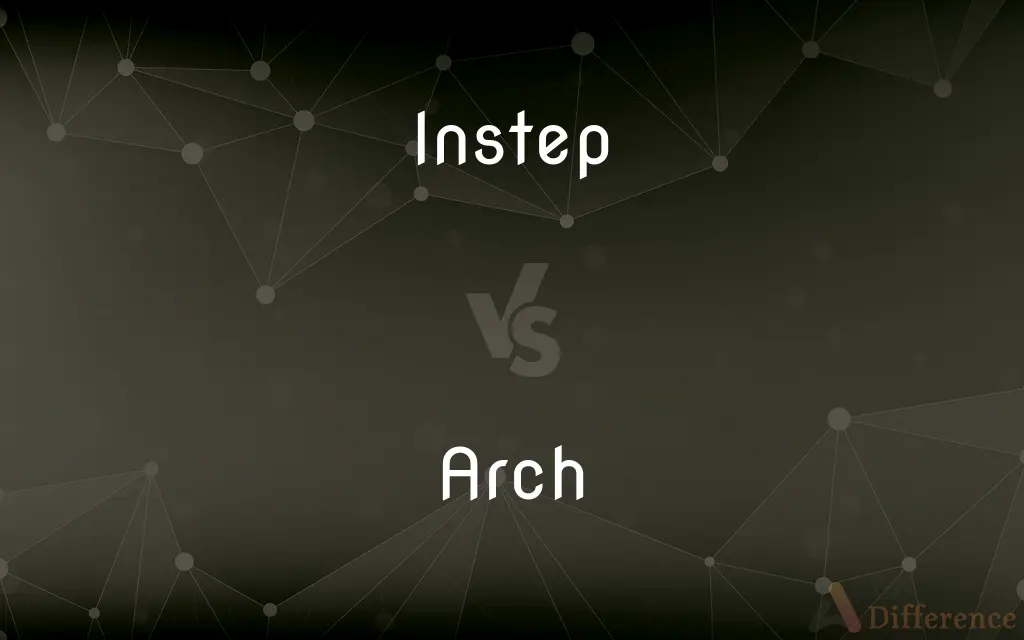Instep vs. Arch — What's the Difference?
By Fiza Rafique & Urooj Arif — Updated on March 24, 2024
The instep is the upper part of the foot between the toes and the ankle, notable for its rise, while the arch refers specifically to the curved underside of the foot that does not touch the ground.

Difference Between Instep and Arch
Table of Contents
ADVERTISEMENT
Key Differences
The instep and the arch of the foot are distinct but related parts of human anatomy, each serving specific functions in foot mechanics and overall posture. The instep is often visible when looking at the foot from the side and is associated with the foot's dorsal (top) aspect. It plays a key role in determining the type of footwear that fits comfortably, as a high instep may require shoes with more room or adjustable closures. On the other hand, the arch, located on the foot's plantar (bottom) side, is crucial for absorbing shock and supporting the body's weight during standing, walking, and running.
Footwear design and fit considerations differ significantly between the instep and the arch. For individuals with a high instep, finding shoes that accommodate the foot's higher rise without causing discomfort is essential. Conversely, shoes designed to support the arch can help prevent conditions such as plantar fasciitis and flat feet, emphasizing the need for supportive insoles or specific shoe designs that cater to low or high arches.
The instep and the arch function together to facilitate efficient movement. The instep's shape can influence how pressure is distributed across the foot, while the arch's flexibility and structure are key to shock absorption and propulsion during the gait cycle. A well-defined arch helps distribute body weight across the feet and legs, whereas the instep's contour can affect the fit and comfort of footwear and the distribution of lace pressure in tied shoes.
From an anatomical perspective, the instep comprises the bones and soft tissues on the foot's dorsal surface, including the metatarsals and the extensor tendons. The arch, however, is formed by the tarsal and metatarsal bones, supported by ligaments and tendons, including the plantar fascia, which plays a significant role in maintaining the arch's shape and functionality.
When addressing foot health and footwear choices, both the instep and the arch must be considered. Proper support for the arch can alleviate pain and prevent injuries, while accommodating the instep's height ensures comfort and prevents constriction. Orthotics and specially designed footwear can address issues related to both the instep and arch, underscoring the interconnectedness of these foot parts in achieving overall foot health and comfort.
ADVERTISEMENT
Comparison Chart
Location
Upper part of the foot between toes and ankle
Curved underside of the foot
Visibility
Visible from the foot's side
Not visible when standing upright
Function
Influences footwear fit and comfort
Supports body weight, absorbs shock
Related to Footwear
High instep may require more room or adjustable shoes
Supportive shoes or insoles needed for high or low arches
Anatomical Components
Metatarsals, extensor tendons
Tarsal and metatarsal bones, ligaments, plantar fascia
Compare with Definitions
Instep
A crucial factor in selecting comfortable shoes.
Shoes with laces or straps can accommodate a high instep more easily.
Arch
A curve that defines foot shape.
High arches require shoes with added support to distribute pressure evenly.
Instep
The dorsal area between the toes and the ankle.
The instep's height varies significantly among individuals, affecting shoe fit.
Arch
The arch's role in reducing impact on the body.
Running shoes with good arch support can prevent injuries.
Instep
Used in fitting custom footwear.
The cobbler measured her instep to ensure the boots would fit comfortably.
Arch
Key to foot stability and balance.
Flat feet result from a collapsed arch, affecting posture and gait.
Instep
The part of the foot used for certain kicks.
Striking the ball with the instep allows for more power and control.
Arch
Can signal potential issues.
Pain in the arch could indicate plantar fasciitis, necessitating medical attention.
Instep
Refers to the foot's arch in ballet.
Dancers often work on elevating their instep for aesthetic purposes.
Arch
Custom supports for the underside of the foot.
Orthotics are often prescribed to support weak or fallen arches.
Instep
The part of a shoe or stocking that covers the instep
Arch
An arch is a vertical curved structure that spans an elevated space and may or may not support the weight above it, or in case of a horizontal arch like an arch dam, the hydrostatic pressure against it. Arches may be synonymous with vaults, but a vault may be distinguished as a continuous arch forming a roof.
Instep
The arched middle part of the human foot between the toes and the ankle.
Arch
A usually curved structure forming the upper edge of an open space and supporting the weight above it, as in a bridge or doorway.
Instep
The part of a shoe or stocking covering the instep.
Arch
A structure, such as a freestanding monument, shaped like an inverted U.
Instep
(anatomy) The arched part of the top of the foot between the toes and the ankle.
Arch
A curve with the ends down and the middle up:the arch of a raised eyebrow.
Instep
A section of any footwear covering that part of the foot.
Arch
(Anatomy)An organ or structure having a curved or bowlike appearance, especially either of two arched sections of the bony structure of the foot.
Instep
In horses, the hind leg from the ham to the pastern joint.
Arch
To provide with an arch:arch a passageway.
Instep
The arched middle portion of the human foot next in front of the ankle joint.
Arch
To cause to form an arch or similar curve.
Instep
The part of a shoe, boot, or stocking covering the instep{1}.
Arch
To bend backward:The dancers alternately arched and hunched their backs.
Instep
That part of the hind leg of the horse and allied animals, between the hock, or ham, and the pastern joint.
Arch
To span:"the rude bridge that arched the flood"(Ralph Waldo Emerson).
Instep
The arch of the foot
Arch
To form an arch or archlike curve:The high fly ball arched toward the stands.
Arch
Chief; principal
Their arch foe.
Arch
Mischievous; roguish
"She ... was arch enough to inform the queen whenever I committed any folly that she thought would be diverting to her majesty" (Jonathan Swift).
Arch
Teasing, ironic, or sardonic
"I know, Edy Boardman said none too amiably with an arch glance from her shortsighted eyes. I know who is Tommy's sweetheart" (James Joyce).
Arch
An inverted U shape.
Arch
An arch-shaped arrangement of trapezoidal stones, designed to redistribute downward force outward.
Arch
(architecture) An architectural element having the shape of an arch
Arch
Any place covered by an arch; an archway.
To pass into the arch of a bridge
Arch
An arc; a part of a curve.
Arch
A natural arch-shaped opening in a rock mass.
Arch
(anatomy) Curved part of the bottom of a foot.
Arch
(obsolete) chief
Arch
To form into an arch shape.
The cat arched its back
Arch
To cover with an arch or arches.
Arch
Knowing, clever, mischievous
I attempted to hide my emotions, but an arch remark escaped my lips.
Arch
Principal; primary
They were arch enemies.
Arch
Any part of a curved line.
Arch
Usually a curved member made up of separate wedge-shaped solids, with the joints between them disposed in the direction of the radii of the curve; used to support the wall or other weight above an opening. In this sense arches are segmental, round (i. e., semicircular), or pointed.
Arch
Any place covered by an arch; an archway; as, to pass into the arch of a bridge.
Arch
Any curvature in the form of an arch; as, the arch of the aorta.
Arch
A chief.
My worthy arch and patron comes to-night.
Arch
To cover with an arch or arches.
Arch
To form or bend into the shape of an arch.
The horse arched his neck.
Arch
To form into an arch; to curve.
Arch
Chief; eminent; greatest; principal.
The most arch act of piteous massacre.
Arch
Cunning or sly; sportively mischievous; roguish; as, an arch look, word, lad.
[He] spoke his request with so arch a leer.
Arch
A curved shape in the vertical plane that spans an opening
Arch
A curved bony structure supporting or enclosing organs (especially arches of the feet)
Arch
A passageway under an arch
Arch
(architecture) a masonry construction (usually curved) for spanning an opening and supporting the weight above it
Arch
Form an arch or curve;
Her back arches
Her hips curve nicely
Arch
(of persons) highest in rank or authority or office;
His arch rival
Arch
(used of behavior or attitude) characteristic of those who treat others with condescension
Arch
Expert in skulduggery;
An arch criminal
Common Curiosities
Can instep height affect athletic performance?
Yes, the instep height can influence the fit of athletic shoes and may affect performance in activities that require precise foot movements or kicks.
How can I tell if I have a high instep?
A high instep is noticeable if the top part of your foot has a pronounced rise, and you may have difficulty finding comfortable shoes that fit well over this area.
Why is arch support important in shoes?
Arch support is crucial for maintaining proper foot alignment, distributing pressure evenly during movement, and preventing injuries.
What does it mean to have a high arch?
Having a high arch means the curved area on the bottom of your foot is more raised than usual, which can affect your gait and require specific footwear for support.
Can problems with the instep or arch lead to other health issues?
Yes, issues with the instep or arch can lead to foot pain, misalignment, and stress on other parts of the body, such as the knees and back.
How do I choose footwear for a high instep or arch?
Look for shoes with adjustable closures, ample room in the upper part, and adequate support or customization options for the arch.
Is it common to have both a high instep and a high arch?
While it's possible, having one does not necessarily mean you will have the other; each foot's structure is unique.
Can exercises strengthen my arch or instep?
Certain exercises can strengthen the muscles around the arch and instep, improving stability and potentially reducing discomfort.
Are there any treatments for a painful instep or arch?
Treatments can include orthotics, physical therapy, stretching exercises, and, in some cases, surgery for severe structural issues.
How do instep and arch issues affect posture?
Problems with the instep or arch can lead to improper foot alignment, affecting posture and potentially causing pain or discomfort in the ankles, knees, and back.
Share Your Discovery

Previous Comparison
Satiety vs. Satiation
Next Comparison
Neoprene vs. ElastomerAuthor Spotlight
Written by
Fiza RafiqueFiza Rafique is a skilled content writer at AskDifference.com, where she meticulously refines and enhances written pieces. Drawing from her vast editorial expertise, Fiza ensures clarity, accuracy, and precision in every article. Passionate about language, she continually seeks to elevate the quality of content for readers worldwide.
Co-written by
Urooj ArifUrooj is a skilled content writer at Ask Difference, known for her exceptional ability to simplify complex topics into engaging and informative content. With a passion for research and a flair for clear, concise writing, she consistently delivers articles that resonate with our diverse audience.











































